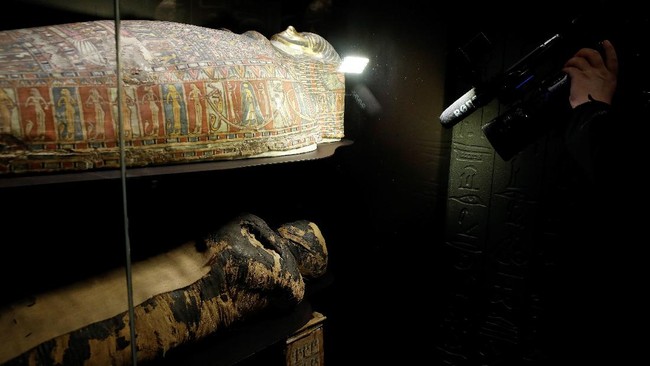Mystery Of The World – A number of world mysteries that were still hidden were finally revealed this year through science, from ancient women to ice men.
Science has changed the way humans understand past events with significant evolution. Meanwhile, paleogenetics has revealed amazing secrets through the analysis of DNA hidden in bones and feces.
Artificial intelligence (AI) also has a role in solving these mysteries, namely by translating ancient texts written in forgotten scripts.
Meanwhile, chemical analysis of molecular residues on teeth, cooking pots, incense burners and building materials has provided deep insights into past diets, aromas and construction techniques.
The following is a list of mysteries of human history that scientists will finally solve in 2023:
Prehistoric female leaders
Buried with elephant tusks, an ivory comb, a crystal dagger, an ostrich egg shell, and a stone dagger decorated with amber, this skeleton discovered in a tomb near Seville, Spain, in 2008 was clearly someone important.
Based on pelvic bone analysis, experts initially identified the 5,000-year-old skeleton as that of a “likely young male” who died between the ages of 17 and 25.
A team of European archaeologists dubbed the remains the “Ivory Man,” and began researching what they called a “spectacular” find.
However, more than a decade later, researchers used a new molecular method in 2021 to confirm the sex of the skeleton as part of a broader study of the discovery, and they were quite surprised.
It turns out that the ‘Ivory Man’ is a woman.
“This is very surprising. So, this really forces us to rethink everything about this site,” said study author Leonardo García Sanjuán, professor of prehistoric sciences at the University of Seville.
The secret of Roman concrete’s strength revealed
Roman concrete has proven to be more durable than modern concrete which can break down within decades. Take, for example, the Pantheon in Rome, which has the largest unreinforced dome in the world.
The scientists behind research published in January said they discovered a mysterious material that allowed the Romans to make their construction materials so durable and build complex structures in challenging places such as docks, ditches and earthquake zones.
In this study, the research team examined 2,000-year-old concrete samples taken from the city walls at the Privernum archaeological site in central Italy. The composition of the concrete is similar to concrete found in various regions of the Roman Empire.
The results of the analysis show that limestone clasts, which are white chunks in concrete, provide the concrete with the ability to close cracks that appear over time.
Previously, these white chunks were considered a sign of careless mixing or low-quality raw materials.
Apparitions of Ötzi the Iceman
Climbers discovered Ötzi’s mummified body in a water channel high in the Italian Alps in 1991.
His frozen remains are perhaps the most studied archaeological find in the world, revealing in unprecedented detail what life was like 5,300 years ago.
His stomach contents provide information about what his last meal was and where it came from, while his weapons suggest he was right-handed, and his clothing provides a rare glimpse of what ancient people actually wore.
But new analysis of DNA taken from Ötzi’s pelvis in August revealed his physical appearance was not what previously thought.
Studies of his genetic makeup show Ötzi the Iceman had dark skin and dark eyes and likely had a large, bald head.
This revised appearance contrasts sharply with Ötzi’s famous reconstruction depicting a pale-skinned man with bushy hair and a beard.
The wearer of a 20,000 year old pendant is revealed
Archaeologists often find bone tools and other artifacts from ancient sites, but it is difficult to know for sure who used or used them.
Earlier this year, scientists discovered ancient human DNA from a pendant made from deer bones found in Denisova Cave in Siberia. With these clues, they were able to reveal the wearer was a woman who lived between 19,000 and 25,000 years ago.
He belonged to a group known as Ancient North Eurasians, who were genetically related to the first Americans.
Human DNA is most likely preserved in deer bone pendants because they are porous and therefore more likely to retain genetic material present in skin cells, sweat and other body fluids.
It is not known why the deer tooth pendant contained such a large amount of ancient female DNA (roughly the same amount as a human tooth).
It’s likely that the DNA was highly favored and worn near the skin for very long periods of time, said Elena Essel, a molecular biologist at the Max Planck Institute for Evolutionary Anthropology in Leipzig, Germany, who developed the new technique for extracting DNA.
AI solves the mystery of the ancient scrolls of Mount Vesuvius
About 1,100 scrolls burned to a crisp during the eruption of Mount Vesuvius nearly 2,000 years ago. In the 1700s, some enterprising diggers discovered a large deposit of volcanic mud.
The collection, known as the Herculaneum scrolls, is perhaps the largest known library from classical antiquity.
However, the contents of the fragile document remained a mystery until a University of Nebraska computer science student won a scientific contest earlier this year.
With the help of artificial intelligence and computerized tomography imaging, Luke Farritor was the first person to decode words written in ancient Greek on one of the charred scrolls.
Farritor was awarded $40,000 (Rp. 616 million) for deciphering the words “πορφυρας” or “porphyras,” which is the Greek word for purple. The researchers hope that it will not be long before the entire scroll can be deciphered using this technique.
Mummy making materials
From pot fragments thrown away in an embalming workshop, scientists discovered several ingredients and potions that ancient Egyptians used to make mummies.
By chemically analyzing the organic residue left inside the vessels, the researchers determined that ancient Egyptians used a variety of substances to anoint the body after death, to reduce unpleasant odors and to protect it from mold, bacteria and decay.
Identified ingredients include vegetable oils such as juniper, fir and cedar, as well as resin from pistachio trees, animal fats and beeswax.
Although scientists had previously learned the names of the substances used to coat the dead from Egyptian texts, they had – until now – only been able to guess exactly what compounds and ingredients they referred to.
The materials used in the workshops were varied and sourced not only from Egypt but also from further afield, thus indicating long-distance exchange of goods.
The dark secret of the Beethoven family
Composer Ludwig van Beethoven died at the age of 56 in 1827 due to chronic health problems, including hearing loss, digestive problems, and liver disease.
Beethoven wrote a letter to his brothers in 1802 asking his doctor, Johann Adam Schmidt, to investigate the nature of the composer’s illness after he died. This letter is known as the Heiligenstadt Agreement.
Nearly 200 years after her death, scientists are extracting DNA from her preserved hair in an effort to meet this demand.
The team was unable to provide a definitive diagnosis. However, Beethoven’s genetic data helped researchers rule out possible causes of his disease such as the autoimmune condition celiac disease, lactose intolerance, or irritable bowel syndrome.
Genetic information also indicated that there had been extramarital affairs in his family.






